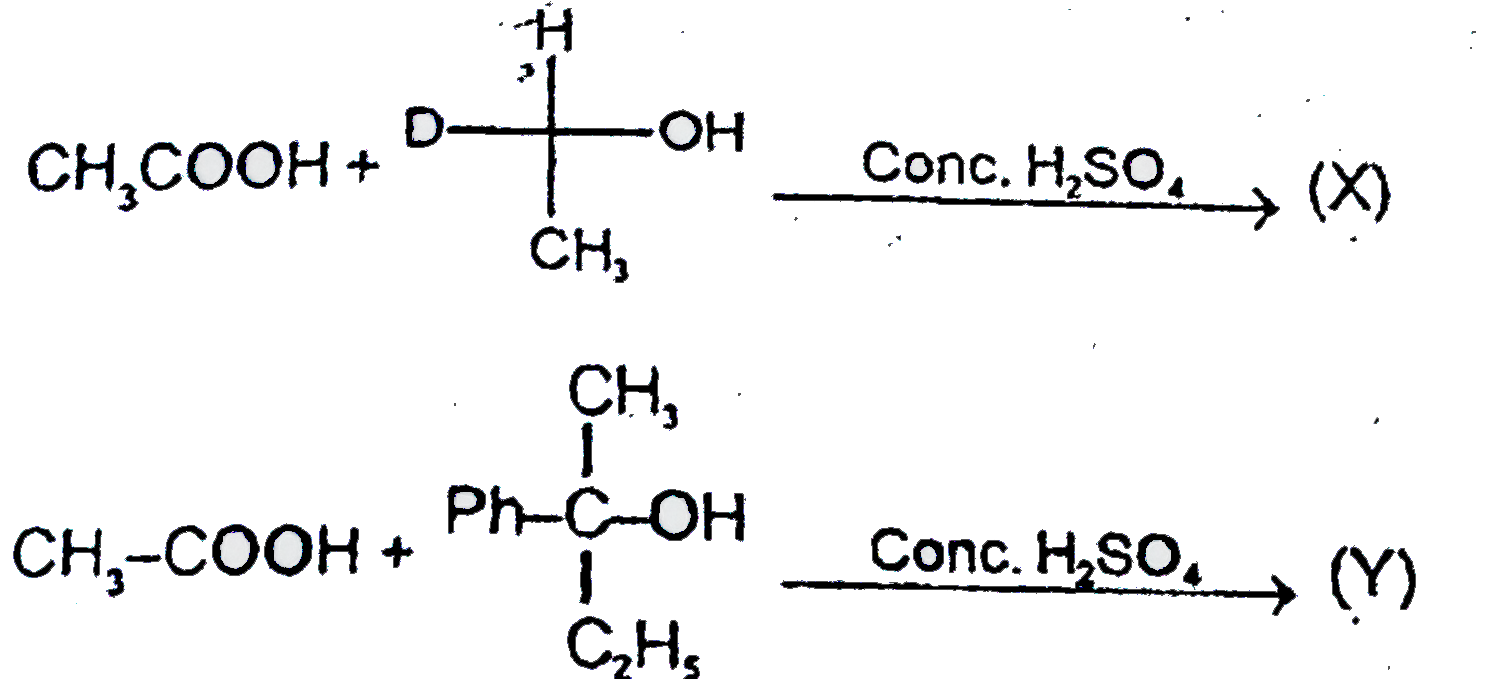Observe the esterfication mechanisms for primary and tertiary alcohols.

(+) Octan-2-ol esterifies with Acetic acid to give optically inactive recemised product.It must have gone by
Type I mechanism
Type II mechanism
Mix type I and type II mechanism
More by type I and less by type II mechanism
The correct Answer is:B
Octan-2-ol is 2∘ alcohol, it forms ester by type -1 mechanism
Topper's Solved these Questions
Similar Questions
Observe the esterification mechanisms for primary and teriary alcohols.

(+) Octan -2-ol esterifies with Acetic acid to give optically inactive racemised product. It must have gone by
View SolutionAn optically active compound [A] C5H13N reacts with alkaline CHCl3 to give an optically active, compound [B]. [A] also reacts with nitrous acid to give an optically inactive alcohol [C] C5H11OH as the major product. What would be the structure of [A]?
View Solution
Knowledge Check
Observe the esterification mechanisms for primary and teriary alcohols.

(+) Octan -2-ol esterifies with Acetic acid to give optically inactive racemised product. It must have gone byAType I mechanismBType II mechanismCMix type I and type II mechanismDmore by type I and less by type II mechanismObserve the esterfication mechanisms for primary and tertiary alcohols.


CH3−COOH+Ph−CH3∣C∣C2H5−OHConc.H2SO4−−−−−−−→(Y)A(X) is optically active while (Y) is optically inactiveBBoth (X) and (Y) are optically activeCBoth (X) and (Y) are optically inactiveD(X) is optically inactive while (Y) is optically activeObserve the esterfication mechanisms for primary and tertiary alcohols.

CH3−COOH+C2H618OHConc.H2SO4−−−−−−−→(P)
CH3−COOH+(CH3)3C−18OHConc.H2SO4Q
In the above reaction (P) and (Q) are respectively :ACH3−O∣∣C−O−C2H6,CH3−O∣∣C−18O−CH3∣C∣CH3−CH3BCH3−O∣∣C−18O−C2H5,CH3−O∣∣C−O−CH3∣C∣CH3−CH3CC2H5−O∣∣C−18O−CH3,CH3−O∣∣C−O−CH3∣C∣CH3−CH3DCH3−O∣∣18O−C2H6,CH3−O∣∣C−18O−CH3∣C∣CH3−CH3
Give the reactions of nitrous acid with primary secondary and tertiary amines..
(b) Name the products with chemical reactions when the following compounds are hydrolysed:
(i) CH3CJH2CN woth dil. HCl
(ii) CH3CN with alkaline H2O2
(iii) C2H5NC with di. HCl
(iv) C2H5NO2 with dil. HCl
(c ) Explain the formation of the mixture of (i) PhCH2CHO and (ii) PhCOMe Ph(CHOH)CH2NH2 (A) is treated with nitrous acid
(d) How nitrobenzene is identified by using Mulliken-Baker test?
View SolutionAn optically active compound [A] C5H13N reacts with alkaline CHCl3 to give an optically active, compound [B]. [A] also reacts with nitrous acid to give an optically inactive alcohol [C] C5H11OH as the major product. What would be the structure of [A]?
View SolutionAmides undergo hydrolysis to yield carboxylic acid plus amine on heating in either aqueous acid or aqueous base. The conditions required for amide hydrolysis are more severe than those required for the hydrolysis of esters, anhydrides or acid chlorides, but the mechanism is similar (nucleophilic acyl substitution). Nucleophilic acyl substitutions involve a tetrahedral intermediate, hence these are quite different from alkyl substitution
(RCH2BrNaCN−−−→RCH2CN)
which involves a pentavalent intermediate or transition state. One of the important reactions of esters is their reaction with two equivalent of Grignard reagent to give tertiary alcohols.
When

is treated with two equivalent of methyl magnesium iodide and the product acidified the final product will be
View SolutionDiane diol worked for several days to prepare compounds shown. She labelled and slept. When she got up all lables had slipped. Her friend Glycol said that They could be easily distuingished by two experiments. Which of the m were optically active.
How many products were obtained when each is treated with periodic acid. after experimentation Diane found the following results
1. Compounds A, E, F were optically active and B, C and D were optically inactive.
2. one product was obtained from the reaction of A, B and D with periodic acid.
3. Two products were obtained from the reaction of F with periodic acid.
4. C and E didnt react with periodic acid.
The structure of the compounds were

Answer the following based on the above observations,
On the basis of the observation which compounds cannot be distinguished ?
View SolutionDiane diol worked for several days to prepare compounds shown. She labelled and slept. When she got up all lables had slipped. Her friend Glycol said that They could be easily distuingished by two experiments. Which of the m were optically active.
How many products were obtained when each is treated with periodic acid. after experimentation Diane found the following results
1. Compounds A, E, F were optically active and B, C and D were optically inactive.
2. one product was obtained from the reaction of A, B and D with periodic acid.
3. Two products were obtained from the reaction of F with periodic acid.
4. C and E didnt react with periodic acid.
The structure of the compounds were

Answer the following based on the above observations,
Which structure could be suggested for A
View Solution
